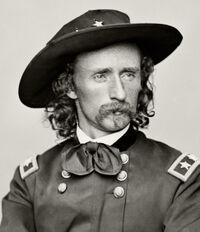George Custer
 From Conservapedia
From Conservapedia | George Armstrong Custer | |||
|---|---|---|---|
| |||
| Born | December 5, 1839 New Rumley, Ohio | ||
| Died | June 25, 1876 (aged 36) Little Bighorn Battlefield National Monument in Montana Resting place: | ||
| Political Party | Democratic Party | ||
| Spouse | Elizabeth Bacon Custer (married 1864-1876, his death) | ||
| Religion | Protestant | ||
| Military Service | |||
| Nickname(s) | Yellow Hair; Iron Pants | ||
| Allegiance | Union Army | ||
| Service/branch | United States Army | ||
| Years of service | 1861–1876 | ||
| Rank | Lieutenant Colonel promoted to Major General; returned as colonel in Indian Wars | ||
| Battles/wars | American Civil War, including: First Battle of Bull Run Battle of the Washita River | ||
George Armstrong Custer (December 5, 1839 – June 25, 1876) was a United States Army officer and cavalry commander in the American Civil War[1] and the American Indian wars in the western portion of the country.[2] His untimely death left his 34-year-old widow Elizabeth Custer to embark on a nearly 60-year effort to promote him as a hero, which was successful until she passed away. Sporting famous "long, golden curls" popular with the public, he had them cut before he met his final demise in battle: "Like the biblical Samson, Custer would find that his haircut was a prelude to disaster."[3]
Custer graduated in 1861 at the bottom of his class from the United States Military Academy at West Point, New York.[4] As the Civil War was just starting, trained officers were in immediate demand. He worked closely with General George B. McClellan, his fellow partisan Democrat who recognized Custer's abilities as a cavalry leader. At the age of twenty-three, he was made brigadier general of volunteers. He fought in at least sixteen Civil War battles and was present at the surrender of the Confederate General Robert E. Lee.
Sent into the Indian Wars thereafter, he met an early demise at the age of thirty-six at the Battle of the Little Bighorn in southern Montana. All of his regiment died in the fight against the Sioux. Custer was buried with his fallne men on the site of the battlefield. However, Custer's corpse was later re-interred at with a hero's burial at West Point.
One of his scouts, James H. "Dog" Kelley, took care of Custer's of dogs. As a parting gift from the Army, Custer gave Kelley, later a mayor of Dodge City, Kansas, a dozen greyhounds. Hence Kelley acquired his nickname, "Dog."[5]
Initially praised largely due to the untiring efforts of his widow Libbie, George Custer's reputation was ultimately shattered by Frederic Van De Water’s GloryHunter (1934) (published a year after Libbie died) and John Ford's classic movie, Fort Apache (1948).
References[edit]
- ↑ George Armstrong Custer | Biography, Battles, Death, & Facts (en).
- ↑ Louis Kraft (September 1, 2006). George Armstrong Custer: Changing Views of an American Legend. HistoryNet. Retrieved on February 6, 2020.
- ↑ https://www.warhistoryonline.com/history/disastrous-attack-led-to-george-armstrong-custers-last_stand-mx.html
- ↑ Duane Schultz (February 6, 2020). West Point's Worst Cadet: George Armstrong Custer.
- ↑ James H. "Dog" Kelley. findagrave.com. Retrieved on April 3, 2021.
Categories: [Ohio] [Montana] [United States Army] [American Civil War] [Democrats]
↧ Download as ZWI file | Last modified: 02/27/2023 17:45:41 | 13 views
☰ Source: https://www.conservapedia.com/George_Custer | License: CC BY-SA 3.0
 ZWI signed:
ZWI signed:
 KSF
KSF